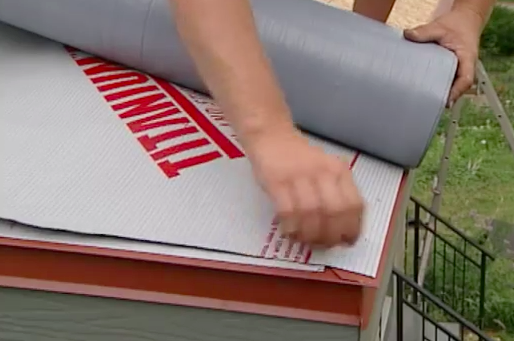Advantages and Disadvantages of Synthetic Roof Underlayment

There are two types of roof underlayment typically in use today – felt and synthetic.
Most roofers are familiar with felt and have used it for years beneath asphalt roofing shingles. Synthetic roof underlayments are newer and come with a number of advantages as well as a few disadvantages to their use. Since the home exterior is so important to both the integrity and the curb appeal of the property, it’s important to use the right materials for the job every time. Take a look at the benefits and drawbacks of using a synthetic roof underlayment to help you make the right choice for your next roof.
Underlayment use
Before you can examine the pros and cons of the different types of underlayment, it helps to determine exactly what this material does. A good underlayment has three distinct purposes.
First, the underlayment acts as a water barrier, preventing moisture from rain or snow from seeping through the roof deck and into the home below. Both synthetic and felt underlayments will do this job.
Second, an underlayment not only prevents water from getting through but also any chemicals that may seep out of the shingles as well. So, when using asphalt roofing shingles on a home, the underlayment helps stop anything from leaching from the shingles and into the deck. Again, both synthetic and felt underlayments are able to perform this job.
Finally, an underlayment gives the roof deck an added layer of protection, mostly against things like heat and sound transfer. The underlayment can, therefore, help prevent things like a superheated attic transferring that heat back into the shingles where it could cause deterioration.
Types of synthetics
While it’s easy to see what you’re getting with a felt underlayment, there are a few different types of synthetic materials on the market. Typically, synthetic roof underlayments are made of one or more of the following materials:
- Polyester
- Fiberglass
- Polyethylene
- Polypropylene
Most of the synthetic materials on the market today are fairly comparable in terms of use and cost. Some may be easier to work with than others or may be recommended for use with a particular shingle type. Otherwise, despite the different materials, most synthetic underlayments offer the same benefits.
Advantages of synthetic roof underlayments
Using a synthetic roof underlayment has a lot of advantages both for the roofer and for the homeowner. First, synthetics are much thinner and lighter weight than felts. This makes them much easier to install, particularly since synthetics don’t tend to be as slippery as felt, which poses less of a safety issue for the installer. Because they’re so thin and lightweight, they don’t add a lot of mass or weight to the roof, yet still, perform well as a water barrier. This makes them an ideal choice beneath some types of heavier or bulkier shingles.
Synthetics are also much more durable and longer-lasting than felt underlayments. This is because the various materials that make up the synthetics degrade at a much slower rate than felt. With newer roofing materials lasting a lot longer than older asphalt roofing shingles, having an underlayment that won’t compromise the integrity of the roof before the shingles fail is a big advantage for homeowners.
For metal roofs, synthetic underlayments offer additional benefits as well. Synthetics can tolerate much higher heats than felt without degrading or compromising the roof. Since metal roofs have a tendency to heat up more quickly than asphalt roofs, it’s crucial that an underlayment is used that can tolerate the high temperatures being generated. Synthetic underlayments used beneath metal roofs also do not require any type of slip sheet, which means the metal is free to expand and contract more easily, resulting in fewer cracks to the underlayment and less damage to the roofing seams.
Disadvantages of synthetic roofing underlayments
Most roofers agree that synthetic roofing underlayments have few drawbacks. Felt does have a better advantage than synthetics, which are much more water-resistant. In addition, synthetics do cost significantly more than felt, which may prove to be a deterrent to homeowners who are looking to replace their roofs on a tighter budget. However, due to the long lasting qualities of synthetics, this becomes less of a disadvantage when looked at over the long-term use of the roof.
Make the right choice
In many cases, the advantages of using a synthetic roof underlayment over a felt are clear. Synthetics last longer and offer better protection from things like heat and normal wear. While they are more expensive, which can put them at a disadvantage for some homeowners hoping to keep their budgets down, the fact that synthetics last longer can help them pay for themselves through more years of use. Make the right choice for your next roof and consider synthetic roof underlayments for the job.
Have a question? AskARoofer.
Find your local roofing contractor in the RoofersCoffeeShop® Contractor Directory.










Comments
Leave a Reply
Have an account? Login to leave a comment!
Sign In